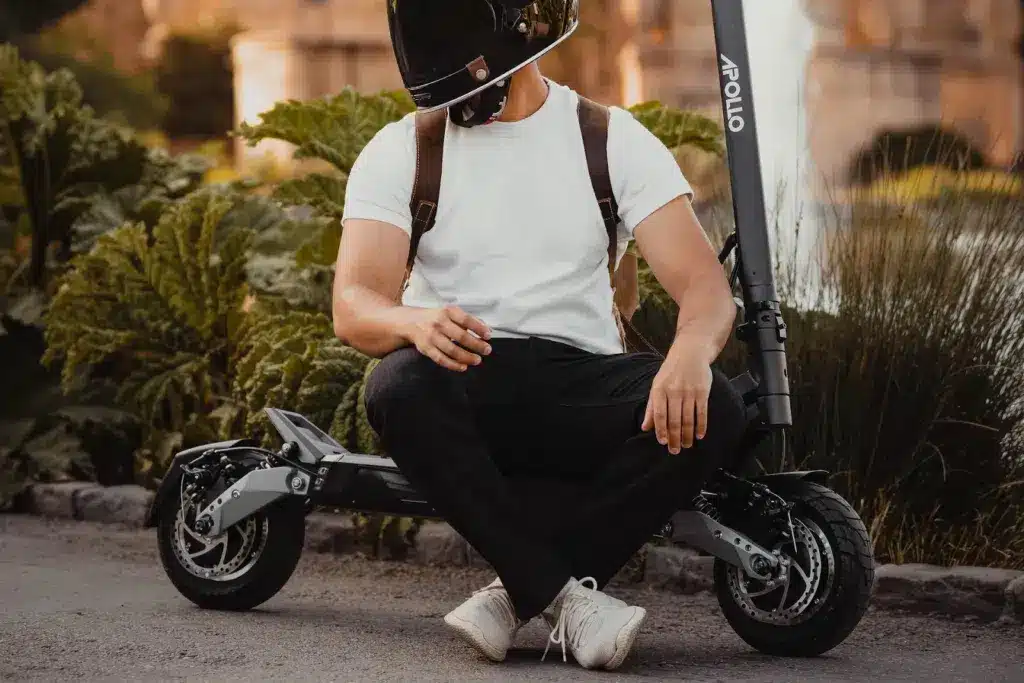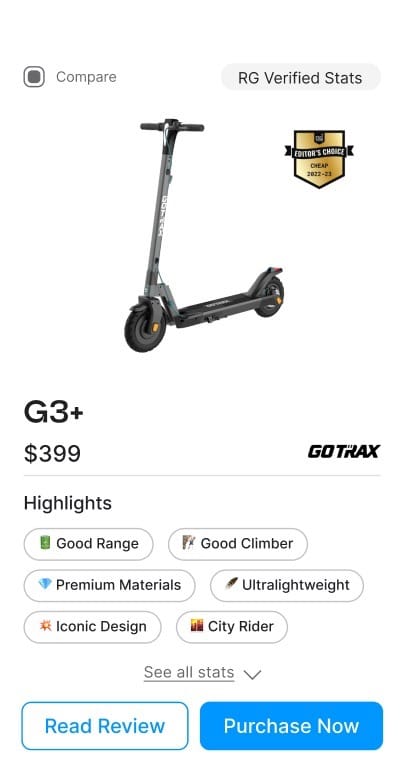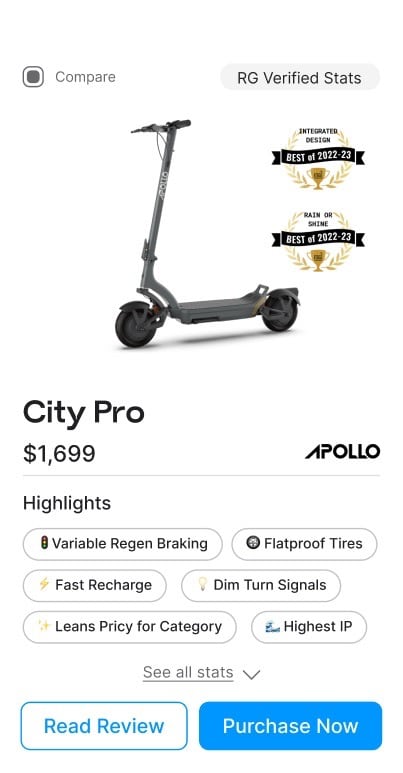The Ultimate Guide to Electric Scooter Helmets


Paul Somerville
Rider Guide’s Editor-in-Chief is a seasoned expert in the electric scooter industry. With a wide-ranging background that includes managing scooter warehouses, selling thousands of motorcycles, and restoring high value (+1M) European sports cars, his expertise is unmatched. Having personally tested more than 100 electric scooters, he offers invaluable insights and recommendations to our readers. We are fortunate to have him as part of our team, as his diverse skill set and extensive experience ensure top-notch reviews.
There are no specific standards from any governing body specifically for electric scooter helmets, though several organizations have laid out helpful guidelines. In this guide, you’ll learn about the helmet safety standards, helmet types for electric scooters, and what you should look for in a helmet.
Electric Scooter Helmets: The Skinny
A helmet is a piece of protective gear worn around the head with the purpose of protecting the skull and brain. Modern electric scooters are fast. We regularly test ones capable of exceeding 40 MPH (64 kmh). Given the combined dangers of much bigger motor vehicles, small scooter tires, and various road hazards, a helmet is an absolute necessity when riding an electric scooter.
However, not all helmets are created equal, nor are all appropriate for electric scooters. Although no governing body has established a formal testing standard for e-scooter use, the general consensus is that a standard bicycle helmet is appropriate for low speed riding, while a motorcycle or ebike helmet should be used for higher speeds.
Based on the available information, our guidelines are as follows:
For riding below 20 mph in low-risk conditions, a helmet meeting bicycle safety standards should be appropriate. For even more protection, you can step it up to a downhill helmet — a type typically used by eskateboard riders and downhill mountain bikers.
When assessing your risk level, keep a few things in mind:
- Riding at night or under poor visibility conditions is higher risk
- Riding in poor weather e.g. snow or rain is higher risk
- Riding at higher speeds or near your top speed for longer is higher risk
- Riding on poor, highly-trafficked or roads without dedicated electric scooter/ bike lane is higher risk
Another important consideration when deciding helmet style is getting one that is comfortable and you will actually wear.
What Type of Helmet for Electric Scooters?
For riding an electric scooter a helmet ranging from bicycle to motorcycle type can be appropriate, depending on your speed and risk. The following types of helmets are appropriate and listed in order of increasing level of protection:
- Bicycle
- Downhill or BMX (Full Face)
- Motorcycle
Bicycle Helmet for Protection

For riding below 20 mph and in low-risk conditions, a helmet meeting bicycle safety standards is appropriate.
Bicycle helmets are the lightest, smallest, most comfortable electric scooter helmets. They come in many styles and price ranges to suite your needs. You can even get a folding electric scooter helmet that can be conveniently stored and unfolded when needed.
In the U.S., the applicable standards are: US CPSC Bicycle, Snell B90A, Snell B95. These standards are all fairly similar, with the Snell B95 being the most stringent. The standards dictate performance on various impact, strap yank, and roll-off tests as well as head coverage requirements.
Downhill or BMX Helmet for More Protection

If you are riding below 20 mph and want more protection, but aren’t ready for a motorcycle or ebike helmet, then a downhill helmet meeting ASTM 1952 or ASTM F2032 is the next step up.
Downhill and BMX-certified helmets are tested to higher impact ratings. If they are full face helmets, such as the one pictured above, the chin bar is also strength tested.
These helmets will offer more protection than a bicycle helmet but aren’t quite as cumbersome as an e-bike or motorcycle. They also tend to be lighter, better ventilated, and more comfortable.
E-bike or Motorcycle Helmet for Even More Protection

For riding above 20 mph (32 kmh) or in higher risk conditions, a helmet meeting the Dutch NTA-8776 ebike standard or a motorcycle helmet meeting Snell M-2005, Snell M-2010, or DOT FMVSS-218 will give you the maximum protection possible.
These types of helmets tend to be larger and heavier than bicycle or downhill helmets. However, they will give you the most head protection possible. If you are riding your scooter in high speed, off-road, or risky conditions then this the only type of helmet you should consider.
Full-Face Helmets

Full face helmets have a so-called chin bar that extends out from your jawline and provides protection for your entire face.
Why full face helmets? Wearing a standard open face helmet, you could still receive severe face trauma in a crash. This can be in the form of a nose, chin, or teeth injury to name a few. Additionally, in certain types of crashes, impact on your face can also transmit severe forces to your brain. Full face helmets with a chin bar can mitigate these types of injuries.
An important note: Only helmets meeting the ASTM F1952 (downhill), e-bike (NTA-8776), or motorcycle standard (DOT FMVSS 218, Snell M-2005, Snell M-2010) are tested for chin bar strength.
How to Find the Perfect Electric Scooter Helmet?
Decide on the Level of Protection You Need
- Minimum (<20 mph): Bicycle Helmet
- More (<20 mph): Downhill Helmet
- Moderate (>20 mph): e-Bike Helmet
- Maximum (>20 mph): Motorcycle Helmet
Measure Your Head Size
- Use a measuring tape to measure the circumference of your head.
- Measure about 1″ (0.5 cm) above your eyebrows.
- Repeat the measurement a few times to make sure you’re getting consistent results.
- It’s helpful to have another person make the measurement for you.
- Most helmet sizes are specified in centimeters (cm). Convert to cm if you’ve measured in inches.
Use Our Helmet Database to Find One in the Right Price Range
Use our helmet database to sort by style, size, price, and level of protection.
We list only helmets that are certified to the appropriate standard (e.g. Bicycle, Downhill, e-Bike, Motorcycle) so you don’t have to worry about keeping all the standards straight in your head.
If a helmet is listed in this database it at least meets the minimum bicycle standard and is from a known manufacturer.
The database also lists all e-bike certified helmets and some certified motorcycle helmets.
Where to Buy an Electric Scooter Helmet
Buying Helmets on Amazon
When buying a helmet from Amazon:
- Buy only from reputable sellers. You can see who the seller is by searching the page for “Sold by.” It will often say “Sold by X and Fulfilled by Amazon.”
- Make sure the helmet model or at least the brand is on our helmet list.
There are numerous sellers online falsely claiming that their helmets meet certain certification standards. Our electric scooter helmet database is built from a variety of authoritative sources and lists the certification for each make and model. The list has more than 1,000 helmets and the manufacturer, at the very least, should be on there.
After You Buy Your Helmet
You can also check the helmet once you receive it to make sure it is compliant. For example, if the CPSC certification label is missing or incomplete, then the helmet is non-compliant and you should return it.
Getting the Perfect Fit
As important as getting a quality helmet that provides protection commensurate with your risk, it’s critical to get one that fits correctly.
A helmet that does not fit correctly will not perform optimally in a crash.
Summary
Choose your helmet in accordance with your risk while riding an electric scooter.
If you tend to ride at lower speeds and are generally isolated from traffic on good quality roads, then you are probably in the low-risk category. If you ride faster, with more traffic, on worse roads, then your risk increases.
Bicycle helmets offer the least protection. Downhill and BMX helmets offer more. Ebike helmets offer more than Downhill. Motorcycle helmets offer the most protection.
Full face helmets, whether they are motorcycle or downhill, offer more protection than open face helmets.
Until the official governing bodies establish a specific e-scooter helmet safety standard, the responsibility falls on you to assess your risk and choose an appropriate helmet. We recommend that riders err on the side of caution. However, the safest helmet is the one you use. If you end up purchasing a more protective one but never wear it, then that is less safe then purchasing a lighter, less protective helmet and wearing it all the time.
You can use our helmet database to find the right helmet that meets your criteria.
Choose your helmet in accordance with your risk while riding an electric scooter.
If you tend to ride at lower speeds and are generally isolated from traffic on good quality roads, then you are probably in the low-risk category. If you ride faster, with more traffic, on worse roads, then your risk increases.
Bicycle helmets offer the least protection. Downhill and BMX helmets offer more. Ebike helmets offer more than Downhill. Motorcycle helmets offer the most protection.
Full face helmets, whether they are motorcycle or downhill, offer more protection than open face helmets.
Until the official governing bodies establish a specific e-scooter helmet safety standard, the responsibility falls on you to assess your risk and choose an appropriate helmet. We recommend that riders err on the side of caution. However, the safest helmet is the one you use. If you end up purchasing a more protective one but never wear it, then that is less safe then purchasing a lighter, less protective helmet and wearing it all the time.
You can use our helmet database to find the right helmet that meets your criteria.
Electric Scooter Helmet Safety Standards
Helmets standards are listed below from order of least to most rigorous, starting with the EN 1078 bicycle helmet standard all the way up to the Snell M-2010 motorcycle helmet standard.
EN 1078 (Bicycle)
This is the European bicycle helmet standard and is less rigorous than the US CPSC standard. Though this type of helmet is sold in Europe for bicycle use, they can’t legally be sold in the United States because they do not meet the minimum safety standard.
US CPSC (Bicycle)
The Consumer Product Safety Commission is the minimum standard for selling a bicycle helmet in the United States market and was established in 1999.
Snell B90A (Bicycle)
Snell B90A is a bicycle helmet standard established by the Snell Memorial Foundation. It is very similar to the US CPSC standard.
Snell B95 (Bicycle)
Snell B95 is a bicycle helmet standard established by the Snell Memorial Foundation. It is the most rigorous bicycle helmet safety standard, though very few bike helmets are certified to it.
ASTM F1952 (Downhill bicycle)
ASTM F1952 is a downhill helmet standard established by ASTM International (the organization formerly known as the American Society for Testing Materials). This standard is more rigorous than any bicycle helmet standard and includes testing provisions for the chin bar of downhill helmet, if present.
ASTM F2032 (BMX)
ASTM F2032 is a BMX helmet standard established by ASTM internation (the organization formerly known as the American Society for Testing Materials). This standard is similar to the F1952 downhill standard.
Dutch NTA-8776 (E-bike)
The NTA-8776 is an electric bicycle helmet standard that is more rigorous than any of the bicycle, downhill, or BMX standards.
DOT FMVSS-218 (Motorcycle)
The US Department of Transportation (DOT) FMVSS-218 is the minimum standard for a motorcycle helmet in the United States. Needless to say, its more demanding than any bicycle or e-bike standard.
Snell M-2010/M-2015 (Motorcycle)
The Snell M-2010 and M-2015 are the most rigorous motorcycle helmet standards.
Frequently Asked Questions
Can you use a bicycle helmet for electric scooter?
Bicycle helmets can be used for riding an electric scooter and are the recommended helmet for low speeds.
Can you use a motorcycle helmet for an electric scooter?
You can use a motorcycle helmet for an electric scooter. It is the preferred type of helmet — especially if you are exceeding 20 mph.
Can you use a snowboard helmet for an electric scooter?
Yes, possibly. If the snowboard helmet is certified to ASTM 2040 then it has been tested to have a similar impact performance as a CPSC-certified bicycle helmet.
Keep in mind that this may not be very comfortable as ski helmets tend to be designed for colder environments. Wearing one in the summer on your electric scooter will probably be uncomfortable!
Can you use a skateboard helmet for an electric scooter?
Yes, but only if the skateboarding helmet is also certified for the CPSC bicycle standard. Most skateboarding helmets meet the ASTM 1492 standard but some may also meet the bicycle standard.
Can you use a downhill helmet for an electric scooter?
Downhill mountain bike helmets can be used for an electric scooter as a substitute for regular bicycle helmet. Downhill helmets that meet ASTM F1952 have a higher standard than regular bicycle helmets. This is due to the fact that crashes are more common in downhill bike racing than road bicycling.
A downhill mountain bike helmet should not be considered a substitute for motorcycle helmet.
Can you use a mountain bike helmet for an electric scooter?
Mountain bike helmets are generally just regular bicycle helmets with a visor and can be used for riding an electric scooter when a bicycle helmet is appropriate. Mountain bike helmets will not offer more protection than a regular certified bike helmet and are not a substitute for a motorcycle helmet.
Can you use a hockey helmet for an electric scooter?
Hockey helmets are not certified for even bicycle-level impacts and should not be used for electric scooters.
Do I need to wear a helmet on an electric scooter?
Yes, you should always wear a helmet when riding an electric scooter. Electric scooters, even budget ones, allow you to ride at your maximum speed most of the time. Most electric scooters will do at least 15 mph and many can exceed 30 mph. Falls and accidents can happen at any time and therefore you always need to wear a helmet.
Should I wear a full-face helmet for an electric scooter?
Not necessarily, but a full-face helmet will offer more protection in an accident. Regular open face helmets won’t protect your chin and face. We recommend that electric scooter riders opt for full-face helmets because they will provide more protection. However, some people don’t find them comfortable. Always choose a helmet that is comfortable that you will wear 100% of the time.







